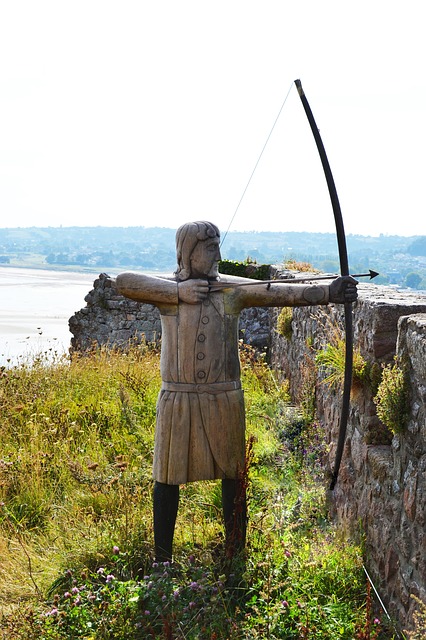By Tim Lambert
The longbow was developed in Wales in the 12th century. In the late 13th century the English conquered Wales but they were impressed by the longbow. The English king, Edward I took Welsh archers into his army. The longbow proved deadly at the battle of Falkirk in 1298 between the English and the Scots. Most of the Scottish army was made up of pikemen (men with long spears). Welshmen and Englishmen armed with longbows rained arrows down on them.
In 1338 England and France went to war. The longbow proved a deadly weapon at the naval battle of Sluys in 1340. Battles at sea were like ones on land. Archers would shoot arrows at the enemy ship then armed men boarded the enemy ship and fought hand to hand. The French crews were hit by a rain of arrows from the English longbows. English soldiers then boarded their ships and killed any who were left.
On land too the longbow proved to be a deadly weapon. The English archers waited for the enemy to attack and then shot volleys of arrows at them. The French were defeated at the Battle of Crecy in 1346. The longbow was used with devastating effect again at the Battle of Poitiers in 1356. The French were crushed again at the Battle of Agincourt in 1415.
Meanwhile, the English king passed a law in 1363 that every man must practice archery on Sundays. Henry VIII passed a similar law in 1515. The yew for making bows was imported. It was so important that in 1472 the king passed a law that every merchant ship that came to England must provide 4 bow staves for every ton of cargo.
In the 16th century, the handgun replaced the longbow. The first handguns were primitive but they gradually improved and by the 1580s the longbow was obsolete. The English navy officially stopped using the longbow in 1595. The last battle to involve the longbow was Tippermuir in Scotland in 1644. The last time a longbow was used to kill was in 1940. A British officer took his longbow to France and he used it to kill a German.
Myths About Archery
There are many myths about archery. The most common is that a French king ordered his men to cut 2 fingers off any captured English archers so they could never use a longbow again. The English archers waved 2 fingers defiantly at the French and that is why we have the obscene 2 finger gesture today. It’s not true! The 2 finger gesture was first recorded in 1901 and it has nothing to do with archery. There is no evidence any French king ever ordered his men to cut 2 fingers off captured archers and there is no evidence the French soldiers ever did that.
It’s another myth that the saying ‘keep it under your hat’ started because archers kept bowstrings under their hats to keep them dry. There is no evidence that archers kept bowstrings under their hats. The saying ‘keep it under your hat’ was not recorded till the 20th century. It started in the 1920s as a joking way of saying keep it secret.
